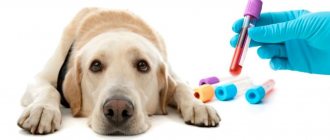Red spots on a dog's belly are easy to notice, since this part of the body is not protected by fur. This symptom can be associated with both serious health problems and non-dangerous conditions in the animal’s life. The appearance of minor redness is not a reason for an urgent visit to the veterinary clinic.
Often the cause of red spots can be contact irritation of the skin from a new overall or an incorrectly selected harness. It is very important to identify the causes of the rash and clearly understand when you can help your pet on your own, and when you cannot do without the help of a specialist.
Main causes:
- Flea and tick bites. The scabies mite provokes sarcoptic mange - a red rash on the body;
- animal, demodicosis - rashes are localized on the animal’s head (around the eyes and mouth);
- Allergic reaction to food allergens, household chemicals and negative environmental circumstances, prickly heat;
- Yeast and fungal skin infection (ringworm);
- Pyoderma is a bacterial skin infection;
- Tumors – benign and malignant lumps;
- Stress factors (neurogenic rashes).
Allergic reaction
Allergies can be easily distinguished by the accompanying symptoms. If a food allergen enters the body, increased thirst and vomiting may occur. Contact dermatitis causes contact dermatitis when the bare skin of the abdomen comes into contact with household chemicals. In this case, in addition to reddened skin areas, constant itching will be observed. To help the animal, it is necessary to stop contact with the allergen.
With an unbalanced diet, an allergic reaction can be caused by certain foods, so it is better if the animal’s diet consists of hypoallergenic food.
Some dog breeds, such as pugs, labradors, sharpeis, bulldogs, due to their physiological characteristics, are more prone to allergies.
Prickly heat
At elevated air temperatures, the animal may develop heat rash. Small redness is localized on the stomach and other parts of the body (skin folds and ears). The animal may suffer from anxiety, lethargy, and increased thirst. If the necessary measures are not taken, wet scabs may develop, which then begin to fester.
The importance of visiting a veterinarian
When the first signs of the disease occur, you should definitely contact a veterinarian to make an accurate diagnosis and prescribe a complex of therapy. Without adequate treatment, serious harm to the animal can be caused. Being constantly in a state of discomfort, the dog tries to get rid of it and combs the existing growths.
The animal can damage the integrity of the skin, which will facilitate the penetration of infection into the dog’s body. As a result, the infection will spread very quickly, covering increasingly deeper areas of the tissue.
Red spots on a dog's belly photo
Carrying out prevention
To prevent the occurrence of dangerous diseases and complications, it is imperative to carry out prevention. First of all, you need to provide the animal with a high-quality, nutritious diet. Preference should be given to natural food, with an emphasis on animal products.
In winter, you should avoid walking on roads treated with deicing agents, as they can trigger allergies. In the summer, you need to minimize prolonged exposure to direct ultraviolet rays. Animals must be promptly treated with antiparasitic agents, and it is also important to undergo preventive vaccinations.
Pyoderma
Pyoderma is an inflammation of the skin caused by the bacterium Staphylococcus intermedius. The microbe is found on the epithelium of healthy animals and leads to inflammation in cases where the condition of the skin allows it to spread in large numbers. When hair follicles become infected, folliculitis develops. The disease is not contagious to humans or animals.
Classic signs of pyoderma are erythema (redness) of the skin, a pustular rash in the lower abdomen, in the form of pimples and ulcers, crusts and scabs may appear. The disease greatly weakens the immune system and skin microclimate, allowing microorganisms to multiply in large numbers.
Pink spots on the body: be careful, ringworm
Scaly patches on the skin of dogs are the first sign of lichen. This is the general name for a group of skin diseases that lead to irritation and hair loss.
Description of the disease and symptoms
Types of lichen:
- Pink.
- Shearer.
- Pityriasis.
- Weeping.
- Encircling.
The first type is practically not dangerous and becomes an aesthetic problem. If the animal is healthy, then the disease goes away on its own in 5-6 weeks. During this period, they carefully monitor their diet and care for their coat. Ringworm is caused by a fungus. Significantly contributes to hair loss, spots with scales appear on the skin. He needs to be treated. The pityriasis appearance provokes spots that do not become inflamed. During the course of the disease, the color changes from pink-red to yellow. Weeping, or eczema, is caused by allergies. Symptoms:
- itching;
- swelling;
- burning;
- redness, blisters, crusts on wounds.
Shingles is caused by the herpes virus. The disease usually appears as spots on the ribs and abdomen. Itching and burning occurs. After scratching the bubbles with liquid, a crust forms.
Treatment
External therapy - ointments and antifungal drugs. It will be more effective if the diagnosis is made by a veterinarian, because different types of lichen are caused by dissimilar pathogens. With widespread use, internal medications, such as tablets, are added.
Is it possible to make a diagnosis yourself?
To independently make a primary diagnosis, veterinarians have developed specific instructions. When identifying red spots on the stomach of dogs, you need to proceed according to the following plan:
- Examine the entire body of the animal to assess the area of lesions. Sometimes, upon careful examination, a tick can be identified;
- Observe whether there are any significant changes in the pet’s behavior - repeated thirst, emerging apathy or constant itching;
- Compare the symptoms with the location of the rash;
- If the clinical signs do not correspond to the above diseases, provide the animal with the necessary assistance;
- If it is impossible to identify the cause of the rash or the treatment is not effective, it is better not to delay a visit to a specialist.
It should be understood that most cases of redness on a pet’s body are not associated with the presence of any serious health changes. Dermatological signs of the disease will quickly disappear after treatment with appropriate external agents.
Diagnostics
It is impossible to determine the nature of the disease by the appearance of the rash, therefore, to obtain the correct, complete treatment, a diagnosis from a veterinarian is necessary. He will conduct an examination and take samples that will indicate the causative agent of the disease. The prescribed treatment will be specialized and comprehensive, which means it will help to quickly cope with the problem and avoid the development of complications.
The best veterinary dermatologists
If the irritation is persistent and cannot be dealt with on your own, then you need to rush to see a veterinary dermatologist:
- Eduard Masimov. Clinic Your own doctor. Moscow.
- Lyubov Kuznetsova. White Fang. Moscow.
- Anna Gehrke. Council. Moscow.
- Ruppel Vladimir. Elena Gerasimova. Clinics of Dr. Sotnikov. Saint Petersburg.
- Bondareva Maria. Kotonai. Saint Petersburg.
- Heinrich Elena. Vetus. Saint Petersburg.
An appointment with a specialist usually costs 1000-1500 rubles.
Quantity
Pests and parasites
Pests and parasites can also be the cause of your dog's rash. Fleas, ticks, and tick larvae can cause irritation, exposing your dog to bacteria, yeast, and fungal infections. Demodex mites, flea allergy dermatitis, sarcoptic mange (caused by the mite Sarcoptes scabiei), and thrombiculosis (a type of mange caused by the parasitic larval stage of mites in the Trombiculidae family) can cause rashes on your dog's skin, including the abdomen and groin area.
Heat rash
Like impetigo, heat rash is caused by staph bacteria and occurs in hot, humid weather. It appears as irritated red patches of skin on the belly, back, folds and under the tail. Causes an itch that makes your dog scratch a lot. May progress to boils, pimples, scabs and give off an unpleasant odor. Cool your dog down by applying cold compresses or ice packs to the area of the rash for about 10 minutes several times a day until the condition improves.
Recommendations for caring for your dog
If your dog has the slightest pimples, it is better to show your pet to a specialist. After all, only he, having examined the patient, will be able to establish the correct diagnosis. If necessary, the patient will undergo tests and a full examination. And if there is a need for this, then antibiotics and hormones are prescribed.
It is necessary, if possible, to get rid of previously used hygiene products for your pet. Before using detergents or cleaning products in the house, check whether they are allergens for the animal. For this purpose, apply a little substance to the skin. If the skin changes color and blisters or rashes appear, then the dog is allergic to this household chemical. And you can’t use it in the house.
To treat the rash, it is carried out with special ointments, powders, creams, lotions intended specifically for animals. In puppies, pimples may appear in the groin if the bedding is wet. Or it will go away on its own with age as the puppy matures. Maintain your pet's hygiene. When bathing him, pay special attention to the folds and groin area. They must always be clean. Never give your pet expired food or low-quality food.
Currently reading:
- The American Cocker Spaniel is an adroit hunter and loyal friend.
- Is it worth it or not to include natural food in your dog’s diet?
- Seven Signs and Remedies for Getting Rid of Fleas in Dogs
- Games to choose for training a dog
Classification of rashes
The spots stand out clearly in color and flora from the rest of the skin. Its nature and form are different. Let's look at the main types of skin rashes:
- macula – red spots;
- urtica (blisters, like a burn) – caused by burns of the dermis;
- nodus (nodules) – require medical examination, are dangerous to health;
- pustules (purulent formations) - indicate an internal inflammatory process and the presence of infection;
- bullae (transparent vesicles) – contain exudate inside and rise above the skin.
Based on this classification, one can judge the causes and signs of the disease. There are different groups that cause pathologies: parasitic (fleas), bacterial, fungal and allergic.
Treatment of the problem
When the parasite is removed from the wound, the surface of the dermis is treated and constant monitoring is carried out for infection. To remove it, use special shampoos and put a collar soaked in a special product on it. , you need to deal with the allergen - the source of the problem. It is better to walk your dog away from flowering vegetation, change food, and remove chemicals. Antihistamines won't hurt - you can carry them with you just in case.
If the dog's harness is rubbing, do not wear it until it is completely healed. Lubricate the affected areas with healing agents. To treat an animal with internal medications, it is better to lure it with affection or tasty treats. Medicines are ground into powder and added to food, sometimes to water. If the rash is neurogenic, you will have to take anti-stress medication, calming drops or tablets. In addition, the owner is recommended to spend more time with his four-legged friend and play with him. A specialist will help you find out the nature of stress.
If the dog's owner has identified alarming symptoms, you should immediately schedule a visit to the veterinarian. The animal itself indicates the problem: the dog licks or behaves restlessly, becomes lethargic. The spots are not fatal; serious diseases develop slowly. However, you cannot delay treatment if it is a small puppy with weak immunity or an old dog.
Impetigo
Impetigo, also known as a staph infection, is a highly contagious bacterial skin disease that appears in puppies as bumps that can be mistaken for pimples.
Most mild cases resolve with a medicated bath twice a week for two to three weeks.
If the disease is not mild enough to be cured with topical treatment, your veterinarian will prescribe oral antibiotics or medicated ointment.
What they look like
The spots vary from person to person and look different. It could be:
- Slight swollen redness. This is most likely an insect bite.
- Small red rash. This is also either a mark from an insect bite or an allergic reaction.
- Pronounced stripes, not too red. Most likely it's chafing.
- Small, scattered red marks that quickly develop into ulcers. This is a sign of a fungal infection.
- A large, round spot with smooth edges. Sign of ringworm.
- Reddish small papules, no more than a few pieces. Sign of folliculitis.
- A voluminous, but not too bright swelling, when pressed, a different consistency of the tissue is felt. A sign of a tumor, benign or cancerous.
- Red spots that, upon closer inspection, turn out to be wounds. This is a sign of nervous exhaustion and stress.
There are many manifestations and diseases; if you look only at the marks, it turns out that many of them are similar to each other - for example, insect bites and folliculitis. To determine what exactly the problem is, you need not only to know the diseases by name, but also to understand what causes them and what symptoms they are usually accompanied by.











